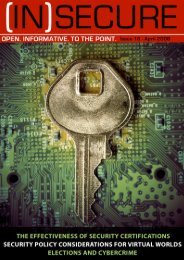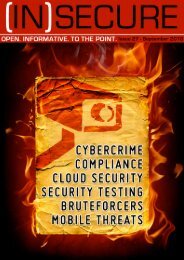download issue 24 here - Help Net Security
download issue 24 here - Help Net Security
download issue 24 here - Help Net Security
You also want an ePaper? Increase the reach of your titles
YUMPU automatically turns print PDFs into web optimized ePapers that Google loves.
Phase 2 - Differentiated access<br />
Once Phase 1 is fully deployed, granular access<br />
control based on roles of the employees<br />
can be implemented. Depending on how your<br />
network is configured and the capabilities of<br />
your wireless controller, granular access control<br />
can range from role-based network segmentation<br />
(VLAN), Access Control List (ACL)<br />
and Qualify of Service (QoS), to a per-user<br />
stateful firewall.<br />
If the right network design is in place, this<br />
phase requires configuration only on the<br />
policy/AAA server:<br />
• Configure policy server to extract user attributes<br />
from the identity store. The extracted<br />
identity attribute can be group, department,<br />
title or any other attribute associated with<br />
user.<br />
• Configure policies to send access control<br />
primitives (VLAN, ACL, etc.) to the wireless<br />
controller, based on one or more of the extracted<br />
identity attributes.<br />
The benefit of deploying phase 2 is that users<br />
get access to network resources based on<br />
their role in the organization. As users move<br />
around in the network, from building to building,<br />
their access permissions follow them<br />
around.<br />
Phase 3 - Advanced access control<br />
Differentiated access deployed in Phase 2<br />
can be further enhanced by taking into consideration<br />
other identity, health or session<br />
based attributes. For example, the following<br />
are some of the attributes commonly used to<br />
provide a finer degree of differentiated access:<br />
• Time of day<br />
• Location<br />
• Access type (wireless, wired)<br />
• Device OS and type (laptop vs. handheld)<br />
• Device health (Anti-Virus, Anti-Spyware)<br />
checks. Device health can be collected and<br />
evaluated by:<br />
" • An agent that is available in the OS<br />
(such as the Microsoft NAP Agent that is<br />
available with the Windows XP SP3, Windows<br />
Vista and Windows 7)<br />
" • A vendor-specific permanent agent.<br />
Machine Authentication (extending employee<br />
access to include known devices)<br />
In many enterprises, devices that the user<br />
logs in from must be corporate approved devices.<br />
Machine authentication can be done<br />
alongside with 802.1 X-based user authentications,<br />
and tied together by the backend policy<br />
system. Machine authentication can be<br />
done by verifying the presence of a machineʼs<br />
MAC address in an inventory database, or by<br />
performing a separate 802.1X machine<br />
authentication against an identity store that<br />
has the “computer” account (For example, Microsoft<br />
Windows computer accounts in Active<br />
Directory).<br />
Tackling guest access<br />
Guests typically get a temporary username<br />
and password to log into the network. They<br />
are given restricted privileges to the network –<br />
typically only Internet access. Since 802.1X<br />
requires computer configuration, enterprises<br />
typically do not enforce 802.1X-based access<br />
for guests. So how is a wireless guest access<br />
handled?<br />
Guest access configuration steps are outlined<br />
below:<br />
Step 1 - Wireless controller configuration<br />
• Configure a guest SSID on the wireless controllers<br />
• Optional data encryption can be configured<br />
by requiring a WPA2 pre-shared key (which is<br />
handed out to the guest, along with the temporary<br />
username and password)<br />
• Access control for this SSID can be statically<br />
configured (unless different guests get different<br />
levels of access, in which case policies<br />
need to be configured on the Policy/AAA<br />
server)<br />
• Configure the authentication servers on the<br />
controller (A policy/AAA server that terminates<br />
RADIUS protocol)<br />
• Most controllers have a built-in guest portal<br />
that acts as a captive portal. The look and feel<br />
of this portal can be customized. Most controllers<br />
also have support for a portal hosted on<br />
an external “guest system”. This latter configuration<br />
has several advantages:<br />
" • A Portal can be used for wired, wireless<br />
and VPN use cases.<br />
www.insecuremag.com 72





